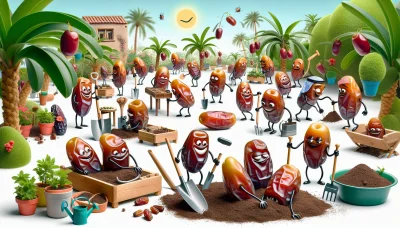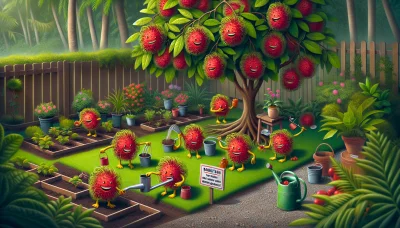How to peel kiwi fruit Quiz
Test Your Knowledge
Question of
How to Peel Kiwi Fruit: A Gardener's Guide
For gardeners and kiwi fruit enthusiasts alike, mastering the art of peeling kiwi fruit is essential. Not only does it enhance the enjoyment and presentation of this delicious, nutrient-rich fruit, but it also maximizes the yield from each harvest. Understanding the proper techniques for peeling can ensure that you get the most out of your home-grown kiwis, making every bite a testament to your gardening skills and dedication to quality.
The Best Time to Peel Kiwi Fruit
Identifying the perfect moment to peel a kiwi fruit can significantly enhance your eating experience, both in terms of flavor and the ease of peeling. The ideal ripeness for peeling a kiwi is when the fruit yields slightly to gentle pressure, similar to a ripe peach. This softness indicates that the fruit is ripe enough to eat, with its sugars fully developed, yet it's not overly mushy, which can make the peeling process messier and the fruit less enjoyable to eat. As for the best season, kiwi fruits are typically at their peak during late fall through early winter. However, thanks to global agriculture, it's possible to find ripe kiwi fruits at grocery stores year-round. Waiting for this optimal ripeness ensures that you'll enjoy the best possible taste and texture from your kiwi fruit.
Tools You Need for Peeling Kiwi Fruit
- Sharp Knife
- Vegetable Peeler
- Spoon
Step-by-Step Guide to Peeling Kiwi Fruit
- Cut off both ends of the kiwi fruit.
- Position your knife just under the skin.
- Gently slide the knife around the kiwi under the skin, being careful not to cut away too much of the fruit.
- Alternatively, you can use a spoon to separate the skin from the fruit. Insert the spoon just under the skin at one end, then rotate the kiwi while holding the spoon steady to peel the skin off in one piece.
- Once the skin is fully removed, the kiwi fruit is ready to be eaten or added to your dish.
Creative Ways to Serve Peeled Kiwi Fruit
Kiwi fruit, with its vibrant green color and sweet-tart flavor, is not only delicious but also packed with nutrients. Once peeled, there are numerous creative ways to enjoy this exotic fruit. One popular option is to slice it and add it to salads, where its unique flavor can complement both sweet and savory ingredients. Kiwi also makes an excellent garnish, adding a splash of color and a burst of flavor to various dishes and desserts. For a simple yet refreshing snack, consider enjoying peeled kiwi on its own or alongside other fruits. Its versatility and health benefits make kiwi a fantastic choice for enhancing your meals and snacks.
Storing Peeled Kiwi Fruit
To maintain the freshness and nutritional value of peeled kiwi fruit, proper storage is key. Once peeled, kiwi fruit should be stored in the refrigerator to slow down the ripening process and preserve its quality. For best results, place the peeled kiwi in an airtight container or a resealable plastic bag to prevent it from absorbing odors from other foods. Additionally, to retain moisture and prevent it from drying out, you can wrap the kiwi in a damp paper towel before placing it in the container or bag. This method helps in keeping the kiwi fresh for about 3 to 5 days. Remember, the colder parts of your fridge are the best spots for storing kiwi to ensure it stays fresh for as long as possible.
Common Mistakes to Avoid When Peeling Kiwi Fruit
- Peeling Unripe Kiwi: Always ensure the kiwi is ripe before peeling. A ripe kiwi should be slightly soft to the touch. If it's hard, let it ripen for a few days at room temperature before peeling.
- Removing Too Much Flesh Along With The Skin: Use a sharp knife or a vegetable peeler and gently peel the skin off to avoid wasting the nutritious flesh. Alternatively, you can cut the kiwi in half and scoop out the flesh with a spoon.
- Not Washing the Kiwi Before Peeling: Even though you're peeling the skin off, it's important to wash the kiwi fruit thoroughly under running water to remove any pesticides or dirt.
- Using a Dull Knife: A dull knife can make peeling more difficult and increase the chance of removing too much flesh. Always use a sharp knife for a cleaner and easier peel.
- Peeling in the Wrong Direction: Start peeling from the top of the kiwi where the stem was. This makes it easier to handle and peel evenly around the fruit.












